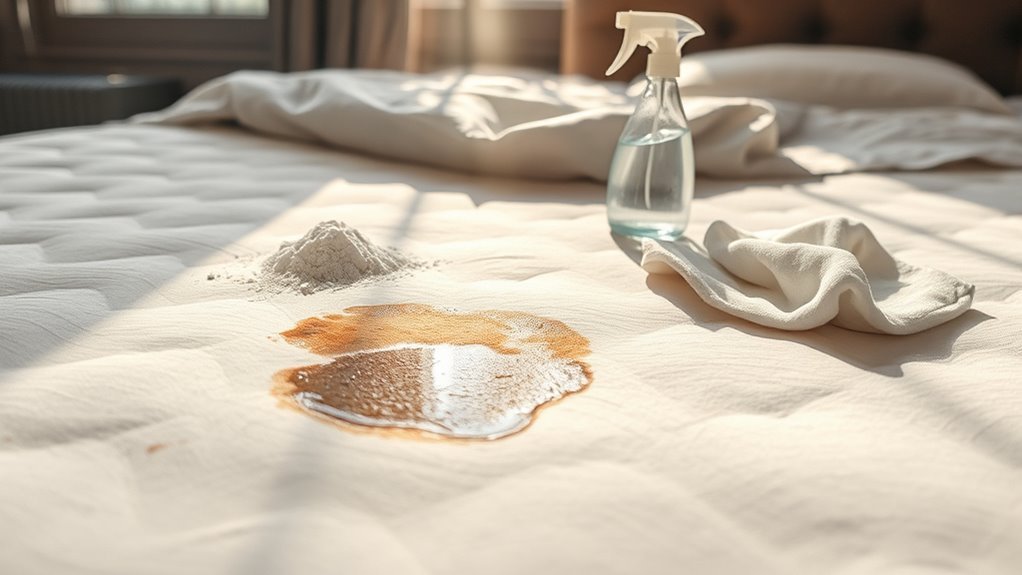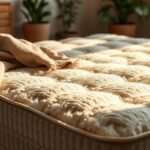To clean a mattress with food stains, start by gathering your supplies like a vacuum, mild detergent, and vinegar. Identify the stain type for effective treatment. If there’s a fresh stain, blot it gently to absorb excess moisture. Mix equal parts water and vinegar, adding baking soda for extra power. Spray the solution, let it sit for 10-15 minutes, then rinse. Verify the mattress dries thoroughly and deodorizers like baking soda can help too. Stick around to discover more tips!
Gather Your Cleaning Supplies
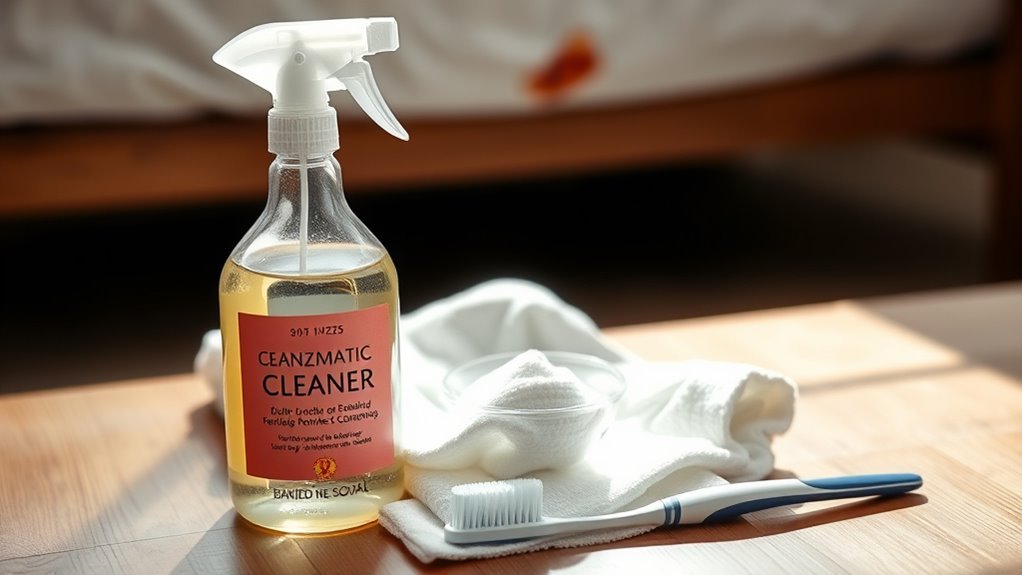
Before you plunge into cleaning your mattress, it’s vital to gather the right supplies, as having everything on hand will streamline the process. Start with a vacuum cleaner equipped with an upholstery attachment to remove dust and debris. For cleaning techniques, you’ll need a mild detergent, white vinegar, and baking soda—these work wonders for spot cleaning and stain prevention. A spray bottle and soft cloths are also essential for applying your cleaning solutions without damaging the fabric. Don’t forget rubber gloves to protect your hands! If your mattress has a removable cover, make sure you wash it according to the care instructions. With these supplies ready, you’ll be well-equipped to tackle any mess and maintain a fresh, clean sleeping environment.
Identify the Type of Stain
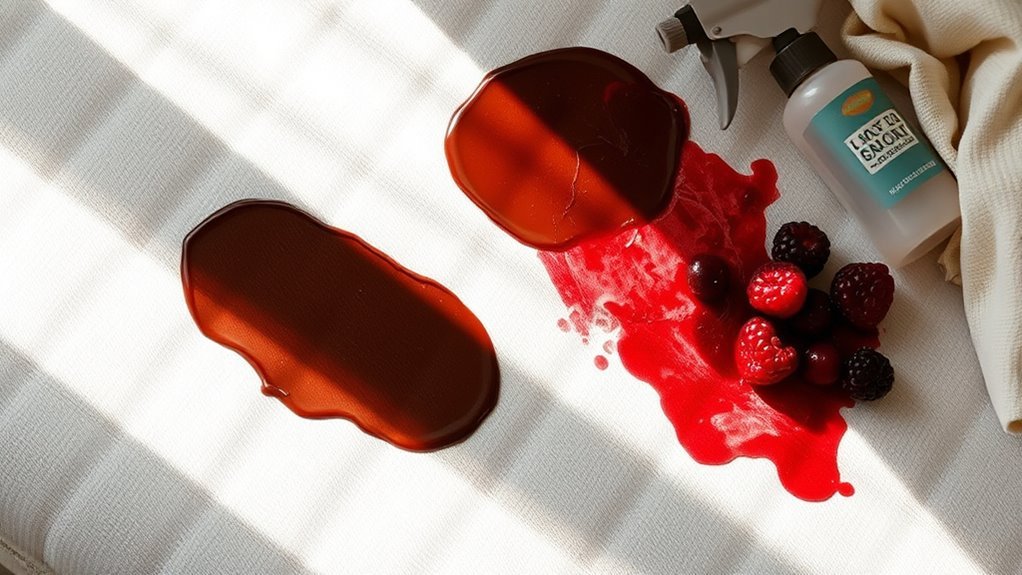
Before you start cleaning, it’s essential to identify the type of stain on your mattress. Common food stains, such as those from chocolate or fruit, each have unique characteristics that require specific treatments. Understanding these distinctions will help you choose the most effective cleaning method for a thorough clean.
Common Food Stains
How can you effectively tackle common food stains on your mattress? Identifying the type of stain is your first step. Pizza sauce, for instance, leaves a vibrant red mark, often accompanied by grease, making it a challenge to remove. On the other hand, chocolate syrup creates a sticky, dark stain that can seep deep into the fabric if left untreated. Understanding these stains helps you choose the right cleaning method. Assess the severity and location of the stain, as this will guide your approach. It’s essential to act quickly, as fresh stains are much easier to clean than old ones. By knowing these common food stains, you’re already on your way to restoring your mattress to its former cleanliness.
Stain Characteristics and Treatments
When it comes to cleaning a mattress, identifying the type of stain is crucial for effective treatment. Different stain types require specific treatment methods to guarantee you don’t damage your mattress. Here’s a quick reference guide to help you determine what you’re dealing with:
| Stain Type | Characteristics | Treatment Methods |
|---|---|---|
| Blood | Dark red, sticky | Cold water and mild detergent |
| Coffee | Brown, darkened | Warm soapy water, blotting |
| Chocolate | Brown, oily | Warm water, vinegar solution |
| Fruit Juice | Bright, vibrant | Cold water and baking soda paste |
Blot the Stain Immediately
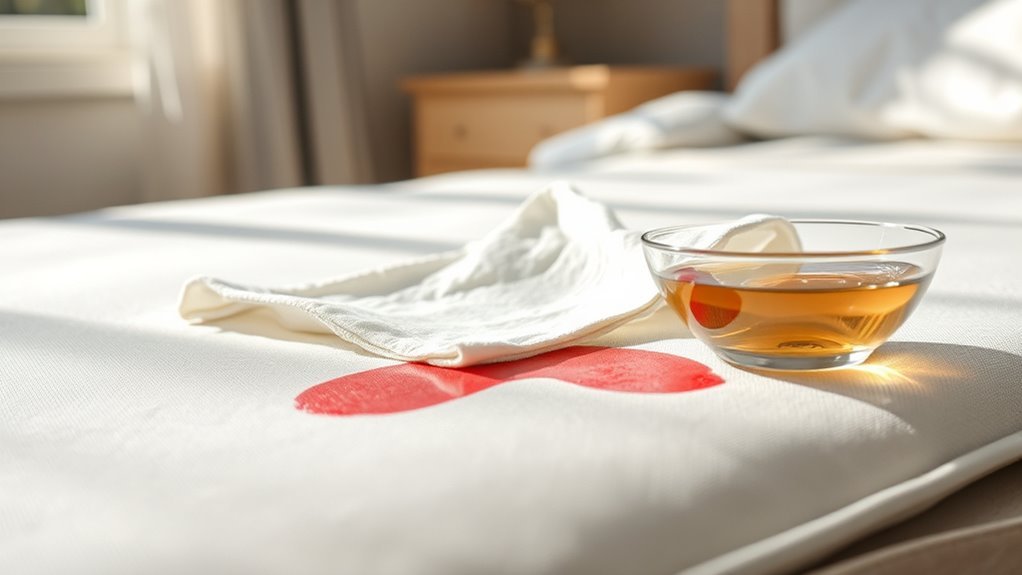
As soon as you notice a stain on your mattress, it’s vital to act quickly to prevent it from setting in. Blotting the stain immediately is an important step in effective stain removal and mattress care. Use a clean cloth or paper towel, and follow these steps:
- Gently press down on the stain to absorb excess liquid without rubbing, which can spread the stain.
- Replace the cloth as it becomes saturated to guarantee maximum absorption.
- Continue blotting until the stain is no longer transferring to your cloth.
Prepare a Cleaning Solution
To effectively clean your mattress, you’ll want to start by choosing safe ingredients that won’t damage the fabric. It’s crucial to mix the cleaning solution in proper ratios to guarantee maximum effectiveness while maintaining safety. Additionally, gather the necessary tools, like spray bottles and soft cloths, to streamline the cleaning process.
Choosing Safe Ingredients
Choosing the right ingredients for your mattress cleaning solution is essential for effective and safe results. Opting for natural alternatives not only protects your mattress but also provides peace of mind. Here are some safe cleaning ingredients you can use:
- Baking soda: This versatile powder helps absorb odors and lift stains.
- White vinegar: Known for its antibacterial properties, it effectively breaks down stains.
- Castile soap: A gentle, plant-based soap that cleans without harsh chemicals.
Mixing Proper Ratios
When preparing your cleaning solution, it’s important to mix the right ratios of your chosen ingredients to guarantee both effectiveness and safety. Start with a base of equal parts water and white vinegar, about one cup each. If you’re adding baking soda for extra stain-fighting power, use two tablespoons. For a touch of fragrance, consider a few drops of essential oil. Remember, getting these cleaning ratios right is vital; too much vinegar might leave a strong odor, while too little may reduce your solution effectiveness. Stir the mixture thoroughly to verify all components are well-blended. Once your solution is ready, you can confidently tackle those pesky food stains, knowing you’ve crafted a powerful and safe cleaning agent.
Essential Tools Needed
With your cleaning solution mixed and ready, it’s time to gather the right tools to make the mattress cleaning process as efficient as possible. Proper mattress care starts with having the essentials at hand. Here’s what you’ll need:
- Soft-bristle brush: Perfect for agitating the fabric without damaging it.
- Clean, absorbent cloths: Use these for blotting and wiping away stains effectively.
- Spray bottle: Ideal for applying your cleaning solution evenly across the stained areas.
Utilizing these tools will enhance your cleaning techniques, ensuring your mattress is not only clean but also well-maintained. By being methodical and prepared, you can tackle those pesky food stains with confidence and keep your sleeping space fresh and inviting.
Apply the Cleaning Solution
To effectively apply the cleaning solution, start by ensuring your mattress is completely stripped of all bedding. This allows the cleaning techniques to reach the stains without obstruction. Using a spray bottle, evenly distribute the solution over the stained areas, ensuring you don’t saturate the mattress. For best solution effectiveness, let the cleaning agent sit for about 10-15 minutes before proceeding to the next step.
Here’s a quick reference table highlighting common stains and recommended solutions:
| Stain Type | Recommended Solution |
|---|---|
| Blood | Cold water & soap |
| Urine | Vinegar & baking soda |
| Red wine | Club soda |
| Coffee | Dish soap & water |
| Ink | Rubbing alcohol |
Keep your mattress fresh and clean with these methods!
Rinse the Area
After allowing the cleaning solution to penetrate the stains, it’s time to rinse the area thoroughly. Proper rinsing is essential to remove any residue that could attract more dirt. Here are some effective rinse techniques you can use:
After applying the cleaning solution, thoroughly rinse the area to eliminate any residue that may attract dirt.
- Use a damp cloth with cool water to gently blot the area.
- For tougher stains, a spray bottle with warm water can help lift residues more effectively.
- Always follow up with a clean, dry cloth to absorb excess moisture.
Dry the Mattress Thoroughly
Once you’ve rinsed the mattress and removed any cleaning solution residue, the next step is drying it thoroughly. Effective humidity control is crucial to prevent mold and odors. Here are some drying techniques you can use:
| Technique | Description |
|---|---|
| Air Drying | Place the mattress in a well-ventilated area, ideally outdoors on a sunny day. |
| Fan Drying | Use a fan to circulate air around the mattress if indoor drying is necessary. |
| Dehumidifier Use | If humidity is high, running a dehumidifier can speed up the drying process. |
Choosing the right technique will guarantee your mattress dries completely, keeping it fresh and safe for use. Remember, a dry mattress is key to a healthy sleeping environment.
Deodorize the Mattress
While your mattress is clean and dry, it’s time to tackle any lingering odors that could disrupt your sleep. Achieving mattress freshness involves effective odor elimination techniques that are simple yet powerful. Here’s how you can deodorize your mattress:
- Baking Soda: Sprinkle a generous amount over the surface. Let it sit for at least 15 minutes to absorb odors.
- Essential Oils: Mix a few drops of your favorite oil with water in a spray bottle. Lightly mist the mattress for a revitalizing scent.
- Vinegar Solution: Combine equal parts water and white vinegar in a spray bottle. Lightly spritz the mattress, then allow it to air dry.
Implement these methods regularly to maintain a fresh sleeping environment and guarantee a restful night’s sleep.
Prevent Future Stains
To keep your mattress in top condition and free from future stains, implementing preventative measures is key. Here’s how you can enhance stain prevention and guarantee mattress protection:
| Action | Description |
|---|---|
| Use a Mattress Protector | Invest in a quality waterproof cover. |
| Regular Vacuuming | Remove dust and debris weekly. |
| Spot Clean Immediately | Tackle spills as soon as they happen. |
| Keep Food and Drinks Away | Enjoy snacks in other areas. |
| Rotate Your Mattress | Flip or rotate every 3-6 months. |
Frequently Asked Questions
Can I Use Bleach to Clean Food Stains From My Mattress?
You shouldn’t use bleach to clean food stains from your mattress. While bleach is effective for certain stain removal tasks, it can damage the fabric and leave behind lingering odors. Instead, opt for a mild detergent or an enzymatic cleaner specifically designed for fabric. These alternatives can effectively tackle food stains without compromising your mattress’s integrity. Always test any cleaner on a small area first to guarantee it won’t cause discoloration or damage.
How Often Should I Clean My Mattress for Best Results?
You should clean your mattress at least every three to six months for ideal mattress maintenance. Establishing a cleaning schedule helps prevent buildup of allergens and odors. Regularly vacuuming and spot-cleaning stains as they occur keeps your mattress fresh. If you notice any spills or stains, tackle them immediately to avoid long-term damage. This methodical approach not only extends the life of your mattress but also guarantees a healthier sleeping environment for your freedom-filled life.
What if the Stain Has Set in for a Long Time?
If the stain’s set in for a long time, don’t despair—there are stain removal techniques that can help. Start by creating a mixture of water and vinegar, applying it with a cloth, and blotting gently. For stubborn marks, consider using a baking soda paste. Just remember, long-term effects of neglecting stains can lead to odors and potential allergens. Regular maintenance can free you from future headaches, keeping your mattress fresh and clean.
Are There Any Natural Alternatives to Commercial Cleaning Solutions?
Yes, there are natural alternatives to commercial cleaning solutions you can use. A baking soda and vinegar solution works wonders. Start by sprinkling baking soda over the stained area, letting it sit for at least 15 minutes to absorb odors. Then, mix equal parts vinegar and water in a spray bottle, lightly mist the area, and gently scrub with a cloth. This method’s effective, eco-friendly, and gives you the freedom to avoid harsh chemicals.
Does Cleaning a Mattress Void Its Warranty?
Cleaning a mattress doesn’t typically void its warranty, as long as you follow the warranty guidelines. It’s important to use approved cleaning methods and avoid harsh chemicals that might damage the materials. Always check your specific warranty terms to guarantee you’re compliant. If you’re unsure, contacting the manufacturer can provide clarity. Keeping your mattress clean can extend its life, so don’t hesitate to maintain it properly!

